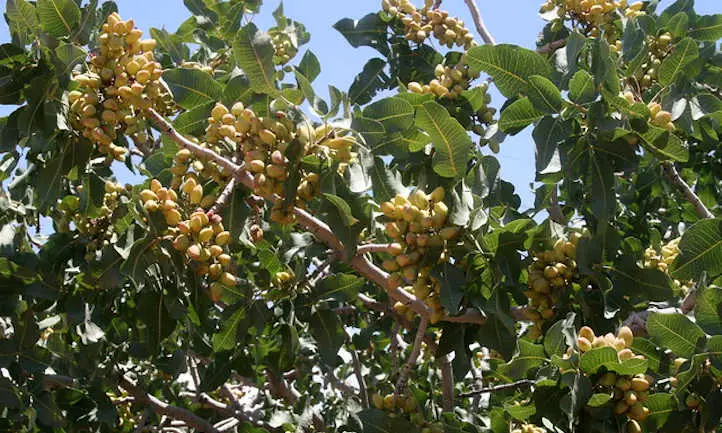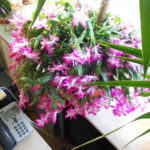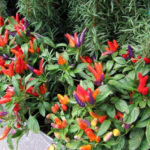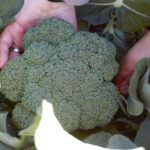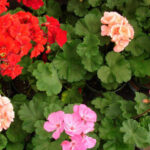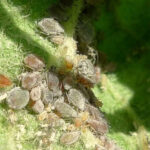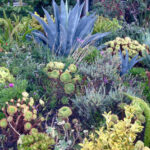Pistachios have exploded in popularity, becoming one of the most convenient and irresistible healthy snacks. Unfortunately, a bag of healthy convenience comes with a high price tag. If your pistachio cravings are weighing heavy on your wallet, growing pistachios may be an excellent option! A fully mature tree can produce anywhere from 20-50 lbs of pistachios. Pistachios can be stored for up to a year, so you will never have to buy pistachios from the store again.
Pistachios are low in calories compared to other nuts while still providing plenty of protein, fiber, and healthy fats. They can be eaten plain or with seasoning. They can be added to salads, topped on vegetables, and even made into ice cream! The possibilities are endless!
Growing pistachio trees requires a lot of patience and space, but the outcome is worth it. Pistachio nut trees are desert plants, so they are drought tolerant and can tolerate a wide temperature range. They are hardy to USDA zones 7-10. Given a good climate, pistachio nut trees are low maintenance and have very few concerns in regards to insect issues and diseases.
Get A Pistachio Tree
Good Products To Grow Pistachios:
Quick Care Guide
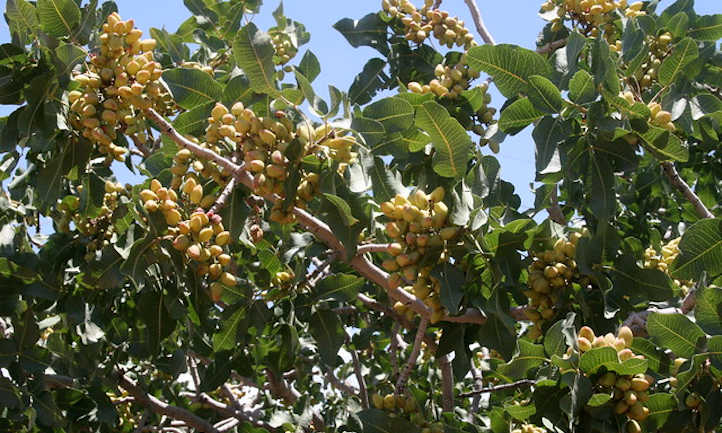
| Common Name(s) | Pistachio |
| Scientific Name | Pistacia vera |
| Days to Harvest | 5-7 years after planting; annually in the late fall |
| Light | Full sun |
| Water: | Low to moderate |
| Soil | Well-draining soils |
| Fertilizer | 10-10-10 NPK annually in the spring |
| Pests | Navel orangeworm, Oblique-banded leafroller, Citrus flat mite, Soft scales, Mealybug |
| Diseases | Botrytis and Alternaria blights; Phytophthora and Verticillium |
All About The Pistachio Tree

Pistacia vera, commonly known as the pistachio, originates from Central Asia and the Middle East. They are accustomed to the desert climate and grow very well in areas such as the San Joaquin Valley of California where there are long hot summers and cool dry winters.
Pistachio trees are deciduous with pinnately compound leaves. The flowers and fruits grow in large clusters. The nut or seed is encapsulated by a hard shell, and the shell is covered in a gold to red hull. At maturity, trees are 20-30 feet in height but can be pruned to control height to a more manageable size.
Pistachios are dormant during the winter, bloom in the spring, develop during the summer, and are ready for harvest in the fall. Trees will bear annually; however, they are alternate bearing so they will bear a heavy crop one year and a lighter crop the following year.
Pistachio trees are dioecious, meaning they are either male or female. In order for the female tree to set fruit, it must be pollinated by a male tree. One male tree can provide enough pollen for up to 11 female trees. Pistachio trees are predominately wind-pollinated, so pollinators are not required to produce fruit. Pistachios also have a chill requirement for flower development. They require at least 800 hours below 45°F.
Planting

Trees are planted as one-year-old trees in January or February. Always plant a grafted tree to ensure that the correct ratio of male and female trees is grown. Planting trees from seed is not recommended because there is no guarantee that there will be a good balance of male and female trees. The only way to determine if the tree is male or female is to wait until maturity which takes several years.
Choose a sunny location with good drainage and a deep soil profile to allow for the roots to grow properly. Growing in a container is not advised, as pistachio requires space for its deep root system. Since female trees are wind-pollinated by male trees, do not place them in an area that is completely blocked from the wind. Male trees need to be planted upwind from females to guarantee pollination.
After choosing a good location for the trees, dig a hole as deep as the root ball and twice as wide. Fill in the hole with soil, compacting with a shovel when complete. Add a layer of mulch to prevent weeds and regulate temperature and soil moisture. Space trees 15-30 feet apart.
Care
Caring for pistachio trees is easy. The most difficult thing about growing a pistachio tree is having patience. Pistachio trees are extremely low maintenance and well worth the wait after you are able to harvest the delicious nuts!
Sun and Temperature
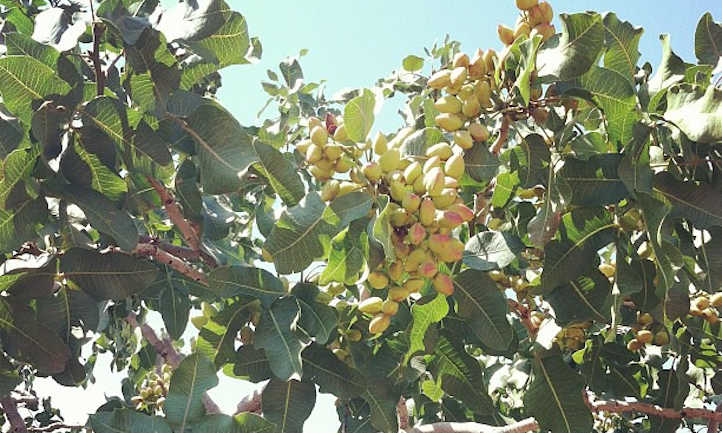
Pistachio trees require full sun, so your growing pistachio needs at least 6 hours of sunlight to achieve optimal growth. Trees are hardy to USDA zones 7-10 and grow well in many parts of the United States, including the southwestern states of Arizona, New Mexico and California. They prefer a climate with a hot and dry summer and cool winters.
Frost tolerance is dependent on the rootstock. Some rootstocks can withstand temperatures below 0°F while others can only tolerate temperatures of 27°F for a short period of time before damage starts to occur. Pistachios naturally grow in desert conditions, so it is extremely heat-tolerant. In fact, dry heat is essential for good kernel development and production. During the dormant period, temperatures above 65°F will cause a reduction in yield.
Water and Humidity
The ideal time to irrigate is in the early morning to prevent conditions conducive to disease development. Extended periods of high humidity can potentially lead to disease problems. Pistachios require deep irrigations every few weeks during dry periods. Pistachio trees are drought tolerant so they will survive with very little water, but providing ample moisture will increase nut yield and quality.
Drip irrigation is ideal to allow the soil to absorb large amounts of moisture. Depending on your soil type, sprinklers and soaker hoses may cause excess runoff. It is not necessary to irrigate during the rainy season.
Soil
Pistachios can grow in a variety of soils provided that they are well-draining. Heavy clay soils are not recommended. Pistachio nut trees can survive in poor soil quality and are known to be salt tolerant. Pistachios prefer slightly alkaline soils between pH of 7.0-7.5 but grow well between a pH range of 6.0-8.0.
Fertilizing
Fertilize once a year in the spring using a balanced NPK fertilizer such as 10-10-10.
Pruning
During the late winter and early spring when the tree is still dormant, prune trees to maintain the size and to keep the canopy open. To keep the canopy open, choose 3 main branches and prune any overlapping smaller branches. Keep smaller branches anywhere from 1.5-2 feet. Keep in mind, the fruit develops on one-year-old growth. When pruning, be cautious to not prune too much of the older branches, as you do need some of the more mature growth.
During the fall and winter, all leaves and fruit should drop naturally. If old leaves and fruit remain on the tree during the dormant period, they need to be removed to prevent carrying diseased plant material into the following season.
Propagation
Pistachio trees are best propagated by grafting. The rootstocks are grown from seed and later budded with the fruiting variety. Rootstocks used for commercial production are different species than Pistacia vera. Pistacia altantica and Pistacia integerrima are the two most common species used for rootstocks. Hybrids of the two species have also been developed to combine the best and most favorable characteristics of the two rootstocks.
When rootstocks are large enough, they are grafted with Pistacia vera. The two most common cultivars are Kerman and Peters. Kerman is a female cultivar and Peters is a male cultivar.
Harvesting and Storing

Harvesting pistachios is very easy and rewarding. Pistachio nuts can be eaten fresh or preserved for later consumption.
Harvesting
Two signs that pistachios are ready to harvest are when the hull turns a reddish color and when the hull splits revealing the shell below. The easiest way to harvest nuts is by laying a tarp below the tree and shaking the branches until the pistachios fall onto the tarp.
Since pistachios split before harvest, do not allow them to land on the ground to reduce the risk of contamination. Remove the hulls immediately after harvest. Failure to remove the hulls will result in shell staining and the potential for mold growth. It also slows the drying process.
Storing
Pistachios will need to be dried and stored in an airtight container. Pistachios can be dried naturally in the sun for 3-4 days or they can be dried in the oven at 140-160°F for around 10-14 hours.
At room temperature, pistachios will keep for a couple of months. For long-term storage up to a year, keep them in the freezer with or without the shell.
Troubleshooting

Growing pistachios is usually problem-free. However, below are some issues that you may run into and how to resolve them.
Growing Problems
Weather conditions are the number one reason for little or no crop yield. Warm weather during dormancy will prevent the tree from producing flowers. Trees need at least 800 hours of temperatures below 45°F. If the tree does not receive adequate chill hours, then flowering is negatively impacted. High temperatures above 65°F during the dormant season will also cause flower loss.
Poor pollination is also a reason for poor fruit yield. Pistachios are largely wind-pollinated. The planting location should be considered to ensure that pollination will occur. Avoid putting them near a wind barrier or placing male trees downwind from females.
Pests
Navel orangeworm adults are moths with gray wings and black markings. Moths lay eggs inside split shells. The larvae are reddish-orange or cream-colored and feed on the pistachio nut. This pest can be managed using cultural methods. Removing old nuts from the previous year will prevent or reduce overwintering pest insects. Harvesting immediately after hull split will avoid the pest from laying eggs in the nuts altogether. If you need a chemical spray, Bacillus thuriengensis (Bt) can be applied for control.
Oblique-banded leafroller is another moth pest of pistachios. Adult moths are brown with darker brown oblique bands on their wings. The larvae feed on leaves and flowering branches. Damage is very obvious in the leaves; the leaves will appear rolled or tied together. The larvae can be found inside the rolled leaves. Larvae are yellowish-green with dark heads. Bacillus thuriengensis (Bt) is very effective in controlling this pest. Weekly sprays may be necessary until full control is achieved.
Citrus flat mite is a small reddish mite that occurs during the summer months. Mites feed on the stems of nut clusters and well as the nuts causing the clusters to shrivel. Damaged clusters tend to stay on the trees rather than falling naturally during the winter providing an overwintering shelter for navel orangeworm and fungal pathogens. If treatment is necessary, citrus flat mite can be treated with sulfur sprays.
Soft scales can be found on the twigs and branches of trees. There are several species of soft scale in a variety of colors ranging from yellow to brown to black. Damage does not come directly from the scale. Scales excrete large amounts of honeydew which leads to sooty mold. Sooty mold covers the leaves which inhibits photosynthesis and leads to leaf drop. Scales are usually controlled with natural predators and parasites. If treatment is necessary, dormant oil sprays are effective.
Mealybugs cause the same issue as soft scales because they also excrete large amounts of honeydew leading to the development of sooty mold. Mealybugs typically reside in the shoots and fruit clusters. Mealybugs are white to gray and produce a white waxy coating around them. Nymphs also referred to as crawlers, are the most mobile stage and typically emerge in June. If natural predators are unable to keep populations under control, pyrethrin can be used for control. Crawlers are the most susceptible to pesticides, so application during the crawler stage is crucial for the most effective application.
Diseases
Botrytis and Alternaria are the two most common foliar diseases in pistachio trees. These two diseases both cause the dieback of leaves and shoots. These diseases occur when conditions are constantly wet, either from rain or high humidity. The most effective way to prevent them is to keep the foliage as dry as possible and to keep trees well pruned so that there is plenty of airflow between branches and leaves.
At the ground level, Phytophthora and Verticillium are the most common root diseases in pistachio trees.
Verticillium starts in the roots and eventually infects the xylem. The infection will obstruct both moisture and nutrient uptake, causing wilting and eventually death. There is no treatment for Verticillium, so prevention is key. If Verticillium is present in the soil, a resistant rootstock must be used to avoid infection.
Phytophthora is a common issue that causes root rot. This fungal issue is completely preventable with proper irrigation practices and good soil drainage. Above-ground symptoms of Phytophthora include reduced vigor and yellow leaves.
Frequently Asked Questions
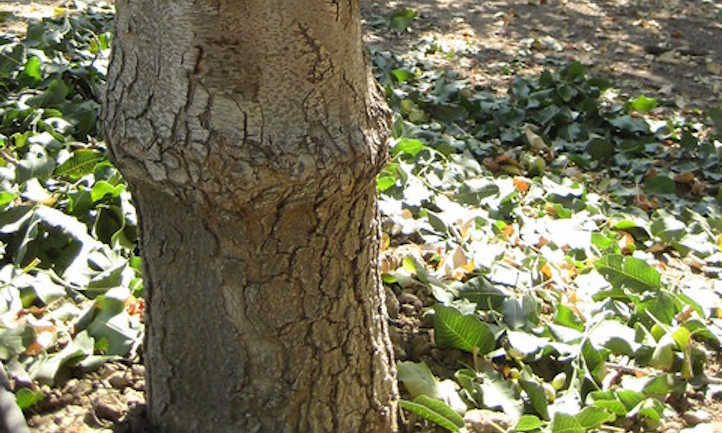
Q: Where do pistachio trees grow in the US?
A: Pistachios are grown commercially in California, Arizona, and New Mexico. Trees are planted in areas of these states where the climate consists of long hot summers and cool winters. California is currently the largest producer in the United States.
Q: How long does it take for a pistachio tree to produce?
A: Pistachio trees take between 5-7 years to produce the first crop. It takes up to 15-20 years to produce peak nut yields.
Q: How tall do pistachio trees grow?
A: Pistachio trees range from 20-30 feet.

